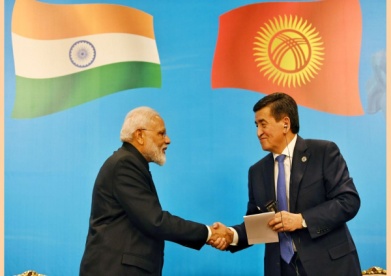
KYRGYZSTAN TAJIKISTAN BORDER TENSION
KYRGYZSTAN-TAJIKISTAN BORDER TENSION

Recently, a ceasefire on the border between Kyrgyzstan and Tajikistan appeared to be holding after a day of intense fighting between the two countries that has killed about 40 people and wounded about 175. Kyrgyzstan and Tajikistan belong to the central asia region. Other countries of the region are Kazakhstan, Turkmenistan, and Uzbekistan.
BACKGROUND OF THE ISSUE
Both nations have claimed the area around the water supply facility in Kok-Tash, a dispute dating back decades to when they were both part of the Soviet Union. The current configuration of the Kyrgyz-Tajik border is the product of Soviet mapmakers drawing the dividing lines for Soviet republics, after the Union of Soviet Socialist Republics (USSR) collapsed in late 1991. The meandering boundary between Tajikistan and Kyrgyzstan is particularly tense as over a third of its 1,000-km length is disputed. Restrictions on access to land and water that communities regard as theirs have often led to deadly clashes in the past.
International Response: Russia and European Union (EU) welcomed the ceasefire deal and emphasised the need for a lasting and peaceful solution.
IMPORTANCE OF CENTRAL ASIA FOR INDIA

Political: India has a very wide array of interests in Central Asia covering security, energy, economic opportunities etc. Security, stability and prosperity of Central Asia is imperative for peace and economic development of India. Central Asia serves as a land bridge between Asia and Europe, making it geopolitically axial for India. Both India and Central Asian Republics (CARs) share many commonalities and perceptions on various regional and world issues and can play a crucial role in providing regional stability.
Economic: The region is rich in natural resources such as petroleum, natural gas, antimony, aluminum, gold, silver, coal and uranium which can be best utilized by Indian energy requirements. Central Asia has huge cultivable areas lying barren and without being put to any productive use, offering enormous opportunity for cultivation of pulses. CARs are fast getting linked to the global market for production, supplies of raw materials and services. They are also increasingly getting integrated into the East-West Trans-Eurasian transit economic corridors.
Indian Initiatives: India intends expansion of International North South Transport Corridor (INSTC) to Afghanistan and Uzbekistan. It will act as a vital gateway to access Eurasian markets and optimally operationalize its use, requiring a Central Asian state joining the project as a direct stakeholder.
India-Central Asia Dialogue: India has proposed setting up of ‘India-Central Asia Development Group’ to take forward development partnership between India & Central Asian countries. This group will help India to expand its footprints in the resource-rich region amid China’s massive inroads and to fight terror effectively, including in Afghanistan.
RELATIONSHIP B/W INDIA & KYRGYZSTAN

Political: India has enjoyed strong bilateral ties with Kyrgyzstan since 1991. India was one of the first countries to establish diplomatic ties with Kyrgyzstan in 1992.
Culture & Economic: Since 1992, the two countries have many agreements, including on Culture, Trade and Economic Cooperation, Civil Aviation, Investment Promotion and Protection, Avoidance of Double Taxation, Consular Convention etc.
Military: In 2011, the joint ‘Khanjar’ series of exercises was started.
Indian Diaspora: In Kyrgyzstan, about 9,000 Indian students are studying medicine in various medical institutions in the country. Also, there are many businessmen living in Kyrgyzstan who are involved in trade and several other services there.
Strategic: The Kyrgyz leaderships have been largely supportive of India’s stand on Kashmir.
They also support India’s bid for a permanent seat at the United Nations Security Council (UNSC).
RELATIONSHIP B/W INDIA & TAJIKISTAN

Political: India and Tajikistan elevated bilateral relations to the level of a Strategic Partnership in 2012. Tajikistan supported India’s membership to the Shanghai Cooperation Organization (SCO) and also permanent membership of an expanded UNSC. India supported Tajikistan's accession to the World Trade Organization in 2013.
Culture & Economic: Trade between two sides is not to expectations despite efforts from both countries, due to more transit time and lack of readily accessible trade routes. Despite limitations, trade in food processing, mining, pharmaceuticals, textiles, skill development, science & technology, Information Technology, culture and tourism are continued between two countries.
India’s Assistance: India delivered major food assistance in 2001-02. To overcome a crisis caused by an unprecedented harsh winter in January-February 2008, India gave a grant of USD 2 million (USD 1 million as cash assistance and USD 1 million in kind, such as power cables, generators and pump sets). India provided 2 million doses of oral polio vaccine through the United Nations Children’s Fund (UNICEF) in November 2010. In March 2018, India gifted 10 Russian-made ambulances to various regions of Tajikistan drawing substantial media coverage and appreciation from high offices.
Indian Diaspora: The total number of Indians is estimated at about 1550, out of which more than 1250 are students.
CONCLUSION
Geography has placed central asia at the nexus of crucial political and economic transformations for centuries. With the actualization of the Belt and Road Initiative, India’s Connect Central Asia policy, and the EU’s new Central Asia strategy, the 21st century could possibly be the most decisive period for the region. Stemming from its historic cultural and economic bonds, India is now well placed to take a more active role in the development of the region. India’s growing global visibility and key contributions to multilateral forums like the SCO have catapulted India from an observer into a critical stakeholder in the region. As India looks beyond its borders, Central Asia provides India with the right platform to leverage its political, economic and cultural connections to play a leading role in Eurasia.












0 Comment